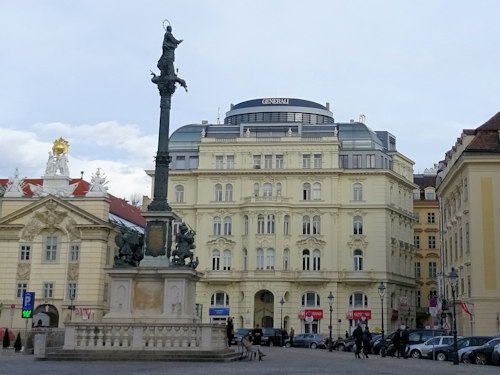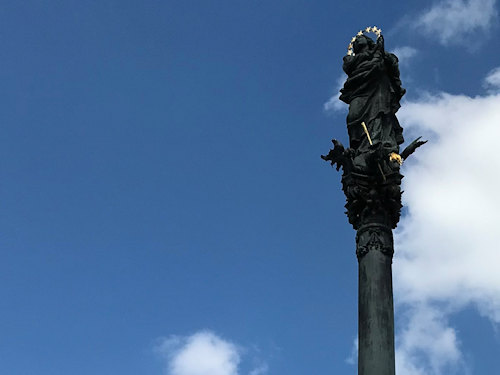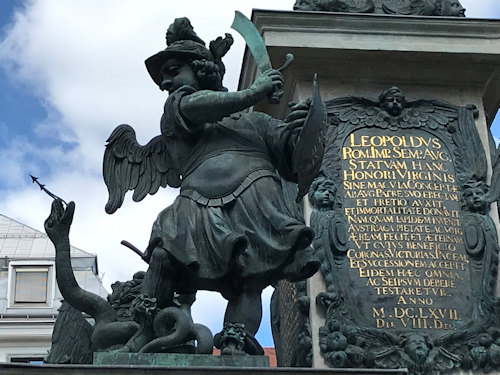
Sometimes, when an army of rampaging Swedes threatens to do unpleasant things to your city, all you can do is hope for divine help. The Mariensäule column on Am Hof square goes back to Emperor Ferdinand III’s act of gratitude for just such an intervention.
- First built in 1647 after Vienna emerged unscathed from the Swedish invasion
- Current Marian column replaced the marble original in 1667
- Famously missing from the Third Man movie
- See also:
The Marian column

(The column and surrounding balustrade)
The term Mariensäule (Marian column) refers to a column topped by a representation of the Virgin Mary, usually erected in gratitude by a monarch or municipal authority for some significant event.
In the case of the Mariensäule on Vienna’s Am Hof square, we must travel back to 1645 and the final phase of the Thirty Years’ War. A Swedish army was happily marching its way through Lower Austria and eventually occupied the fortress of Korneuburg, just a few miles up the Danube from Vienna.
Things looked grim for the Habsburg Emperor of the time: Ferdinand III.
When you’re a monarch, appealing to higher powers than yourself involves limited options. But Ferdinand promised that if the Swedes left Vienna alone, he’d put up a monument in honour of the Virgin Mary by way of thanks for positive intervention from above.

(The virgin Mary)
Fortunately for the city, the vagaries and complexities of war did indeed take the bulk of the Swedish army off in another direction. Habsburg forces even recaptured Korneuburg in 1646.
Ferdinand had dodged a bullet (or musket ball).
So, true to his word, the Emperor had the Mariensäule built in marble by a certain Johann Jakob Pock with the unveiling in 1647. Pock and his brother contributed a further important work to Viennese history: the main altar in Stephansdom cathedral.
Although since dismantled, two fountains once flanked the location, as this picture from the late 19th century shows:

(A photo of the square sometime before 1883 by the Michael Frankenstein & Comp. photo studio; Wien Museum Inv.-Nr. 79000/1246; excerpt reproduced with permission under the terms of the CC0 licence)
If the column seems inspired by the 1638 Mariensäule on Munich’s Marienplatz square, that’s because it was. The Munich predecessor also went up in thanks for the city’s avoidance of significant damage during the same war.
Observe the Mariensäule today, however, and much of it looks suspiciously metal, rather than marble: in 1667, Emperor Leopold I replaced the original with the largely bronze version that now occupies Am Hof’s centre.
The “old” marble column went off to a friend of the court; it still stands today on the banks of the River Inn in Upper Austria, close to the town of Wernstein am Inn.
The symbolism of the column is relatively transparent.
The Virgin Mary stands on top above a speared dragon. Around the base of the plinth, four Putti deal similar fates to a snake, basilisk, lion, and another dragon (representing heresy, plague, war and famine).

(A death-dealing cherub)
Although the religious importance of the column has faded somewhat, the Mariensäule still occupies a soft spot in Viennese hearts. Not least because it often sits at the centrepiece of events like the Am Hof Christmas and Easter markets.
(You may find the monument partly obscured should such an event be taking place.)
Not in The Third Man
Rather oddly, the 17th-century column also has a movie claim to fame. Or rather, a movie claim to no fame.
One of the classic scenes in The Third Man sees Holly Martins spot the presumed-dead Harry Lime for the first time. The ensuing chase takes the pair out into Am Hof square, where Lime simply disappears.
Despite the clear shot of the square, the Mariensäule has also done a disappearing trick. It seems the (fake) sewer entrance featured in the film blocks our view of the column.
How to get to the Mariensäule
Check the Am Hof article for directions.
Address: Am Hof, 1010 Vienna